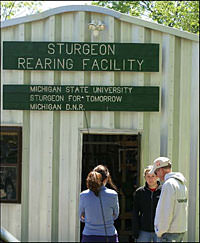2007 Lake Sturgeon Research
Streamside Rearing Facility
Moving to Kleber Dam Site in 2008
By James Crossman, Michigan State University
In 1994, the DNR entered into a settlement agreement with the Tower-Kleber hydro-project owners through the Federal Energy Regulatory Commission (FERC) licensing process. Among many things, this agreement contained a clause that stated, “…if a rearing facility is necessary for the sturgeon propagation activities of the MDNR, the utility will work with MDNR in constructing the rearing facility.

Since that time, the MDNR Fisheries Division has invested more than $2 million in research and monitoring to investigate the appropriate ways to go about sturgeon rehabilitation. Over the past couple of years after careful review of the current scientific information, Fisheries Division realized the time was right to develop this sturgeon rearing facility to rehabilitate sturgeon in the Black River system, starting with Black Lake. We have learned much from ongoing research about streamside rearing and are ready to move beyond a research-only phase and into a rehabilitation phase for lake sturgeon.
We are pleased to announce that the resource agencies, MDNR, MDEQ, and the U.S. Fish and Wildlife Service along with the Tower Kleber Limited Partnership have an agreement in principle for this facility and that the Tower-Kleber Limited Partnership will be investing in the building of this facility in the coming year.
The formal FERC process will require filing of the appropriate paperwork and plans in November or December 2007. FERC will then need time to review the specific plans and provide comments back to the agencies and Tower- Kleber Limited Partnership for a finalized agreement for signing.
The primary purpose of the facility will be to raise young sturgeon for the purposes of rehabilitation. The facility will consist of two buildings, one for incubation and rearing of the juvenile sturgeon and one for outdoor rearing to stocking size. The outdoor facility will be the facility that was previously located downstream. Unlike other fish, sturgeon require a lot of “floor” space and thus we need a larger area to raise these fish compared to other fish.
The production target will be about 3,300 young sturgeon per year. This annual number is based on a projected number of 65,000 fish stocked over 20 years to achieve a desired level of 2,000 adult sturgeon in Black Lake. This produces a density similar to that of Lake Winnebago in Wisconsin.
In addition to the rehabilitation program, the facility will provide a platform for continued research to help us better understand the limitations to sturgeon production and survival and to help us continue improving our management and rehabilitation programs for sturgeon statewide.
Timeline: the facility should be up and running by fall 2008, and ready to receive the first round of youngsters in spring 2009.
The agreement for the facility will be in place through the life of the current license which expires in 2024.
The above information was submitted by Tammy Newcomb, Ph.D., Lake Huron Basin Coordinator, Michigan DNR Fisheries Division.
SFT anticipates providing outreach, education, perhaps in the form of an interpretive center, and any and all other means necessary and proper to assure management of this facility produces the sustainability in the resource. We would also like the thank Gil and Brenda Archambo for the use of their river property that supported the past three years of rearing.
- Home Page
- Black Lake
Sturgeon Shivaree - Black Lake Watershed
- Black Lake Sturgeon Management Plan
- Committees
- Contact Us
- Directors
- Events
- Habitat Conservation
- Membership
- Newsletters
- Our History
- Photo Gallery
- Research
- Resources
- Resources for Educators
- SFT Scholarships
- Spearing Guidelines
- State Regulations
- Sturgeon Guarding
- Sturgeon Hatchery
- Sturgeon in the Classroom

